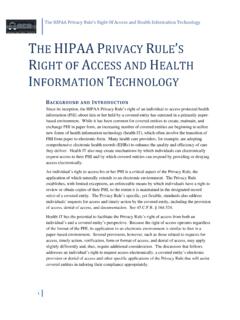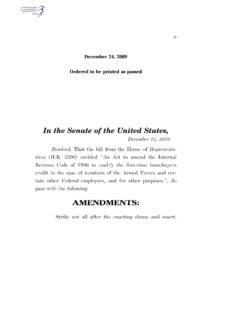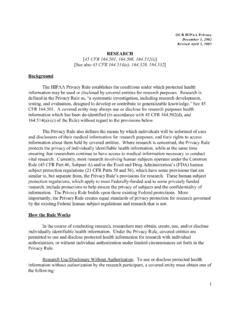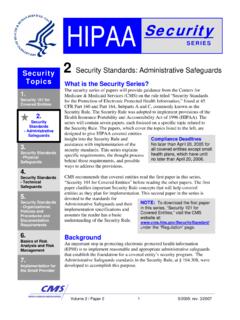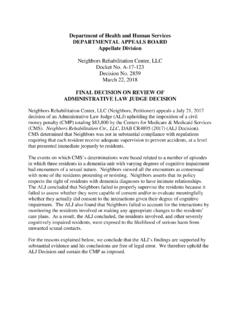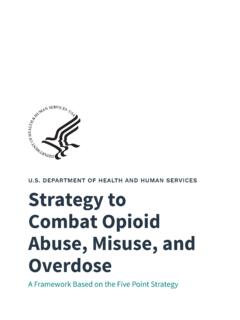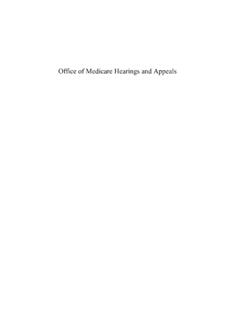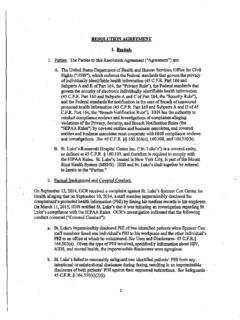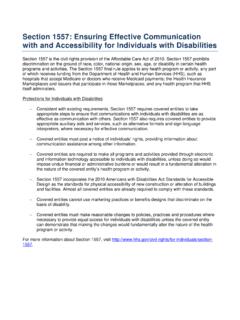Transcription of Decision by Departmental Appeals Board - hhs.gov
1 Department of Health and Human Services Departmental Appeals Board Civil Remedies Division Director of the Office for Civil Rights v. The University ofTexas MD anderson cancer center . Docket No. C-17-854 Decision No. CR5111 Date: June 1, 2018 Decision I grant summary judgment in favor ofthe United States Department of Health and Human Services, Office for Civil Rights (OCR) and against Respondent, The University ofTexas MD anderson cancer center . I sustain imposition ofthe following remedies against Respondent: To remedy Respondent's noncompliance with 45 (a), civil money penalties of$2,000 per day for each day ofa period that began on March 24, 2011 and that continued through January 25, 2013; and To remedy Respondent's noncompliance with 45 (a), civil money penalties of$1,500,000 per year for the years 2012 and 2013.
2 The daily civil money penalties that I impose remedy Respondent's failure to encrypt electronic devices including laptop computers and USB thumb drives pursuant to the requirements oflaw. The annual civil money penalties that I impose remedy Respondent's unlawful disclosure ofelectronic Protected Health Information {"4ePHI") relating to about 30,000 individuals in 20 l 2 and more than 3500 individuals in The term "ePHI" encompasses electronically stored 1 These numbers are approximate but they are not disputed. It is unnecessary that I make findings as to the exact number ofindividuals whose ePHI Respondent unlawfully disclosed. 2 protected information about patients consisting of: identifying information such as patient names, addresses, and Social Security numbers; and clinical infonnation such as diagnoses, assessments, prognoses, and treatment regimes.}
3 I. Background OCR moved for summary judgment against Respondent and Respondent cross moved for summary judgment. With its motion OCR filed 85 proposed exhibits that it identified as OCR Ex. I-OCR Ex. 85. In opposing the motion and cross moving Respondent filed 80 proposed exhibits that it identified as R. Ex. 1-R. Ex. 80. OCR filed a briefand a reply brief in support of its motion. Respondent filed a brief in opposition to OCR's motion and a sur-reply brief. In referring to the parties' briefs in this Decision I refer to "OCR brief," "OCR reply," 'Respondent brief," and "Respondent sur-reply." I do not receive the parties' proposed exhibits into evidence. It is unnecessary inasmuch as I base this Decision solely on undisputed material facts. I refer to some of the exhibits but only to illustrate facts that are not disputed.
4 II. Issues, Findings of Fact and Conclusions ofLaw A. Issues This case concerns Respondent's alleged failure to comply with regulations implementing the Health Insurance Portability and Accountability Act of 1996 (HIPAA). 42 1320d-5; 45 Part 160, Subpart D and 45 Part 164, Subparts A, C, D, and E. Essentially, OCR alleges that Respondent failed to comply with regulatory requirements in two respects: { 1) it failed to perfonn its self-imposed duty to encrypt electronic devices and data storage equipment; and (2) it allowed ePHI to be disclosed. The issues raised by OCR' s allegations are whether: 1. Respondent failed to comply with HIPAA regulatory requirements; and 2. OCR's determinations to impose civil money penalties against Respondent are reasonable. Respondent opposes OCR's assertions and its determinations ofregulatory violations.}
5 It denies that it was obligated to encrypt its devices. It asserts that it did not contravene regulatory requirements governing disclosure ofePHI. It contends that the ePHI at issue is "research" and is not subject to HIPAA non disclosure requirements. It argues that the penalties that CMS determined to impose against it are unreasonable and contrary to that which is pennitted by regulation. I address these arguments in this Decision . 3 Respondent makes three additional arguments that I do not address. First, it contends that as an agency ofTexas' state government its activities lie beyond the reach ofHIPAA. It argues that it is not a "person" as is defined by HIPAA. Respondent briefat 21-26. Respondent concedes that it is a "person" within the meaning of the regulatory definition ofthat term at 45 Respondent asserts that the regulation's definition ofa "person" exceeds the statutory definition of that term.
6 Effectively, Respondent's argument is that the regulations published by the Secretary of the United States Department ofHealth and Human Services ("'Secretary") are ultra vires HIPAA because they unlawfully broaden the statute's definition of"'person" to include an agency ofa state government. I have no authority to address this argument. My authority to hear and decide this case rests entirely on a delegation from the Secretary. Nothing in that delegation authorizes me to find that the Secretary's regulations are ultra vires. See 45 Consequently, I must apply those regulations to the facts of this case. Second, Respondent argues that OCR ignored statutory caps on civil money penalties in determining the penalties that it requests that I impose. Respondent briefat 50-53. It contends that HIP AA, as amended, allows at most, penalties of $100,000 per year, and it contends that regulations that allow higher penalties than this asserted $100,000 annual ceiling constitute a misinterpretation of the statute.
7 See 45 .R. This argument is a second attempt by Respondent to have me declare regulations to be ultra vires. I have no authority to consider this argument for the reasons that I have explained. Respondent argues, however, that I have the authority to reduce civil money penalties, citing 45 (b). It asserts that I should reduce the proposed penalties to amounts at or below the asserted statutory cap because doing so would adhere to statutory limitations. I may not do that, first, because to do so would constitute an end run around the Secretary's intent as expressed in the regulations and second, because in evaluating civil money penalty amounts I must limit my review to the aggravating and mitigating factors set forth at 45 Third, Respondent asserts that the civil money penalties proposed by OCR violate the excessive fines provision ofthe Eighth Amendment of the United States Constitution, and it asks me to declare those proposed penalties to be arbitrary and unconstitutional.
8 Respondent briefat 58-62. I do not address this argument because my delegated authority does not include the authority to declare unconstitutional proposed actions by agencies of this Department. 4 Respondent, professing to recognize the limits of my authority, asserts that I should apply the principles embodied in the Eighth Amendment to the facts of this case even ifI do not declare the proposed penalties to be unconstitutional: That is yet another effort by Respondent to have me exceed my limited authority. I decide the reasonableness ofthe penalty amounts strictly based on the criteria set forth in the applicable regulations. B. Findings of Fact and Conclusions ofLaw 1. Respondent's Noncompliance with Regulatory Requirements The Secretary published regulations that implement those sections of HIP AA that require him to promulgate standards for the electronic exchange, privacy, and security of health information.
9 These regulations are set forth at 45 .R. pt. 160 and 45 pt. 164, subpts. A, C, D, and E. In general entities that are covered by these regulations are required to: ensure the confidentiality, integrity, and availability of all ePHI that the entities create, receive, maintain, or transmit; protect such information against any reasonably anticipated threats or hazards to its security; protect ePHI against any reasonably anticipated impermissible uses and disclosures; and ensure compliance with these requirements by their workforces. 45 (a). Additional regulations implement these requirements. OCR alleges that Respondent failed to comply with certain ofthese implementing regulations. OCR alleges that Respondent failed to comply with the requirements of 45 OCR brief at 25-26.
10 This regulation requires, at subsection (a){ 1 ), that an entity covered by HIP AA must implement technical policies and procedures for , electronic information systems that maintain ePHI to allow access only to those persons or software programs that have been granted access. Put more simply, the subsection requires a health care provider to protect its electronic information systems from disclosure ofePHI to unauthorized individuals or data At subsection .(a)(2), the regulation requires a covered entity to implement, among other things, a mechanism to encrypt and decrypt ePHI. OCR asserts that Respondent violated these regulatory requirements because it failed to assure encryption oflaptop computers and USB drives that contained ePHI generated or maintained by Petitioner or its staff.}
